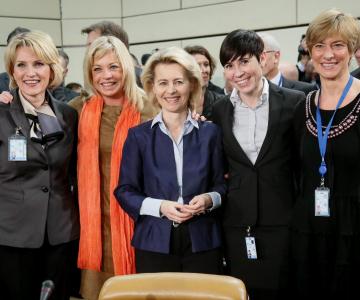Project: Vulnerable Groups And Security Sector Reform: LGBT Case Study03Mar2014
Gender And NATO: A Good Start But Challenges Ahead
 Does the appointment of female defence ministers in the Netherlands, Norway, Sweden, Germany and Italy herald a new era for women in the once exclusively male world of «hard» military power?
Does the appointment of female defence ministers in the Netherlands, Norway, Sweden, Germany and Italy herald a new era for women in the once exclusively male world of «hard» military power?
The jury is still out. True, NATO Secretary General Anders Fogh Rasmussen has appointed Mari Skåre as a first-ever Special representative on Women, Peace and Security with a three year mandate which ends in September 2014. Skåre has tried to ensure that, at least at the political level, gender issues are integrated into NATO structures and policies. Ahead of NATO’s summit in September, the focus is on the rights of Afghan women, especially in the post-2014 period.
Less is said, however, about NATO’s success in mainstreaming gender questions into its own operations and structures. Although United Nations Security Council Resolution (UN SCR) 1325 on women, peace and security was adopted over a decade now, NATO has started taking some concrete steps to mainstream gender into its operations only recently. NATO leaders, meeting in Lisbon in 2010, expressed for the first time their commitment to the implementation of the UNSCR 1325: “We have today endorsed an Action Plan to mainstream the provisions of UNSCR 1325 into our current and future crisis management and operational planning, into Alliance training and doctrine, and into all relevant aspects of the Alliance’s tasks”.
An updated Euro-Atlantic Partnership Council policy on “Implementing UNSCR 1325 on Women, Peace and Security and related resolutions” was developed in 2011. NATO’s Strategic Commands are currently reviewing the Comprehensive Operations Planning Directive (COPD) as well as the document on “Integrating UNSCR 1325 and gender perspectives in the NATO command structure including measures for protection during armed conflict”. Action plans for the implementation of the UN Resolution have been developed both by NATO Headquarters Allied Command Operations (ACO) and the Allied Command Transformation (ACT) in areas such as operations, training and public diplomacy.
In addition to reviewing its policy frameworks, NATO also established gender advisors, both at the operational and tactical level. Numerous challenges persist, however.
There is a misunderstanding of the role of these gender advisors among mission personnel. Many believe their task is to deal with internal issues related to sexual harassment and/or the promotion of female military personal. There is no clarity on how a gender advisor can, if at all, contribute to the success of a military mission. This situation is further complicated by the lack of gender training for incoming mission personnel.
Gender advisors have different job descriptions, even within the same mission. In Afghanistan, gender advisors have different roles and responsibilities depending on whether they are part of the Regional Command North, Regional Command South or the Regional Command Central. This makes it difficult to get a clear idea of their responsibility.
The very high turnover rate of military personnel (every six to nine months) requires on-going training by gender advisors. With only one gender advisor per mission, this is extremely difficult. If gender advisors are also responsible for other tasks, such as establishing contacts with key stakeholders on the ground and participating in strategic planning meetings, their job becomes even more complicated.
Unclear roles and job descriptions lead, sometimes, to unclear chains of command. Initial organograms of some of the NATO missions, show gender advisors reporting to the chief of staff or to the commander of the mission. This is, however, not always the case. Gender advisors are also part of the communications division.
These challenges can be addressed as follows:
Misperceptions of the roles and responsibilities of gender advisors can be easily addressed by making in-country gender training mandatory before deployment. Ideally, these training packages should start in the home-country and continue into in-theater training. To this end, a central approval authority should be established to review training across NATO member countries and ensure standardisation. This will allow gender advisors to also focus on other mission objectives, such as the establishment of relevant internal and external contacts or the review of plans and strategies to ensure the inclusion of a gender perspective in policies.
Additionally, because gender advisors have an operational role with a crosscutting dimension, similar to the legal or psychological advisors, they should be able to work in close cooperation with and report directly to the commander of the mission and not the chief of staff or any other high ranking official. This direct link fosters support from the commander for the mission and ensures that he/she is able to ensure gender mainstreaming in the NATO operation.
As NATO leaders prepare for the summit in September and reflect on the rights of Afghan women, much still remains to be done within NATO and national military structures on the status of women in the military. Achieving these goals will allow NATO to talk in a credible way on gender issues on the global stage.
Irina Bratosin is Programme Manager at Security and Defence Agenda (SDA).



